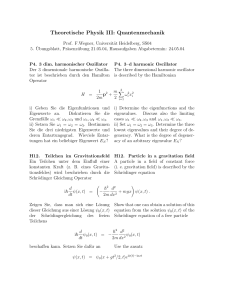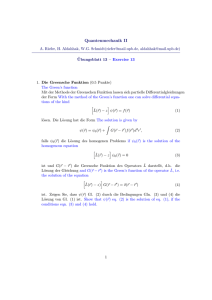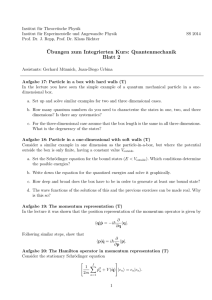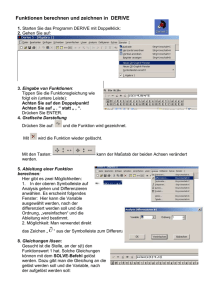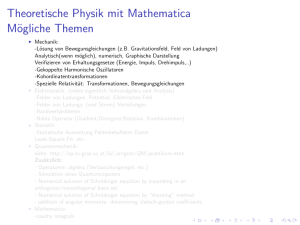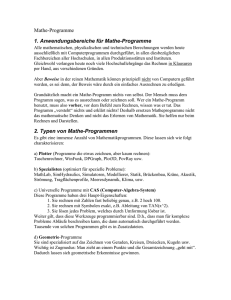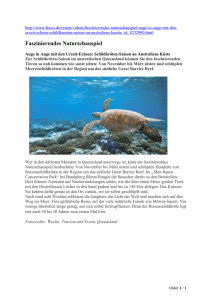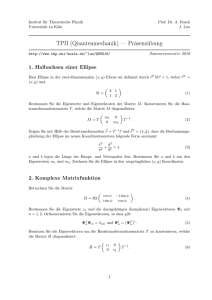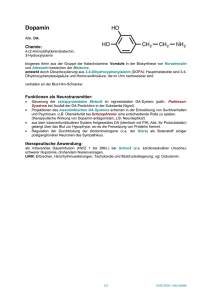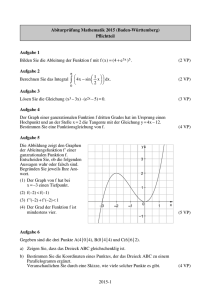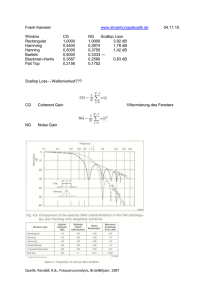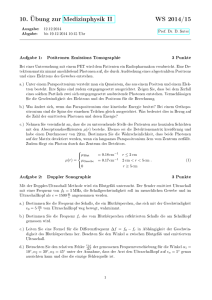Übungsblatt Nr.4
Werbung
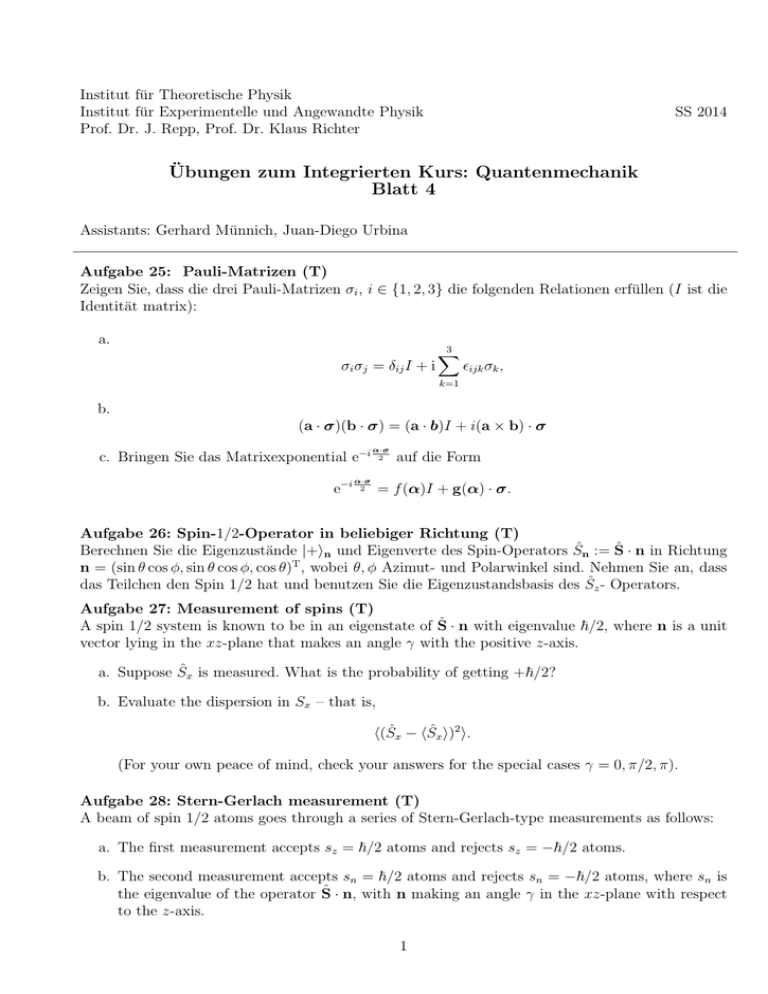
Institut für Theoretische Physik
Institut für Experimentelle und Angewandte Physik
Prof. Dr. J. Repp, Prof. Dr. Klaus Richter
SS 2014
Übungen zum Integrierten Kurs: Quantenmechanik
Blatt 4
Assistants: Gerhard Münnich, Juan-Diego Urbina
Aufgabe 25: Pauli-Matrizen (T)
Zeigen Sie, dass die drei Pauli-Matrizen σi , i ∈ {1, 2, 3} die folgenden Relationen erfüllen (I ist die
Identität matrix):
a.
σi σj = δij I + i
3
X
ijk σk ,
k=1
b.
(a · σ)(b · σ) = (a · b)I + i(a × b) · σ
c. Bringen Sie das Matrixexponential e−i
e−i
α·σ
2
α·σ
2
auf die Form
= f (α)I + g(α) · σ.
Aufgabe 26: Spin-1/2-Operator in beliebiger Richtung (T)
Berechnen Sie die Eigenzustände |+in und Eigenverte des Spin-Operators Ŝn := Ŝ · n in Richtung
n = (sin θ cos φ, sin θ cos φ, cos θ)T , wobei θ, φ Azimut- und Polarwinkel sind. Nehmen Sie an, dass
das Teilchen den Spin 1/2 hat und benutzen Sie die Eigenzustandsbasis des Ŝz - Operators.
Aufgabe 27: Measurement of spins (T)
A spin 1/2 system is known to be in an eigenstate of Ŝ · n with eigenvalue ~/2, where n is a unit
vector lying in the xz-plane that makes an angle γ with the positive z-axis.
a. Suppose Ŝx is measured. What is the probability of getting +~/2?
b. Evaluate the dispersion in Sx – that is,
h(Ŝx − hŜx i)2 i.
(For your own peace of mind, check your answers for the special cases γ = 0, π/2, π).
Aufgabe 28: Stern-Gerlach measurement (T)
A beam of spin 1/2 atoms goes through a series of Stern-Gerlach-type measurements as follows:
a. The first measurement accepts sz = ~/2 atoms and rejects sz = −~/2 atoms.
b. The second measurement accepts sn = ~/2 atoms and rejects sn = −~/2 atoms, where sn is
the eigenvalue of the operator Ŝ · n, with n making an angle γ in the xz-plane with respect
to the z-axis.
1
c. The third measurement accepts sz = −~/2 atoms and rejects sz = ~/2 atoms.
What is the intensity of the final sz = −~/2 beam when the sz = ~/2 beam surviving the first
measurement is normalized to unity? How must we orient the second measuring apparatus if we
are to maximize the intensity of the final sz = −~/2 beam?
Aufgabe 29: Spinpräzession (T)
Der Hamiltonoperator eines Spin- 1/2 Teilchens mit Magneton µ und gyromagnetischem Faktor g
im äußeren magnetischen Feld B ist
gµ
Ĥ = − Ŝ · B.
~
Die magnetische Flussdichte B sei in z- Richtung orientiert. Das Teilchen befinde sich zum Zeitpunkt
t = 0 im Eigenzustand |+in zum positiven Eigenwert des Spin-Operators Ŝn in Richtung n =
(sin θ cos φ, sin θ cos φ, cos θ)T .
a. Geben Sie die Erwartungswerte der Operatoren Ŝx , Ŝy , Ŝz im Anfangszustand an. Was ergibt
sich in den Fällen, in denen dieser ein Eigenzustand von Ŝz oder Ŝx ist?
b. Finden Sie die Zeitentwicklung |ψ(t)i des Zustands mit Hilfe der zeitabhängigen Schrödinger
Gleichung
∂
i~ |ψ(t)i = Ĥ|ψ(t)i.
∂t
c. Geben Sie die Erwartungswerte hŜi(t) = hψ(t)|Ŝ|ψ(t)i in der Form hŜi(t) ∝ n(t) mit φ =
φ(t), θ = θ(t) an.
d. Was lässt sich allgemein über einen unbekannten, beliebigen Spin-1/2- Zustand aussagen,
wenn die zugehörigen Erwartungswerte hŜi = s gegeben sind? Begründen Sie Ihre Antwort.
Aufgabe 30: The radial equation of the hydrogen atom (E)
In the lecture you have seen that the radial part of the Schrödinger equation satisfies
l(l + 1)~2
~2 1 d
2 d
r
R(r) + V (r) +
R(r) = ER(r)
−
2µ r2 dr
dr
2µr2
a. Show that, by setting R(r) = u(r)/r, above equation becomes
~2
l(l + 1)~2
00
−
u(r) + V (r) +
u(r) = Eu(r)
2µ
2µr2
(1)
(2)
b. Bring the above equation to the form
xy 00 (x) + (l + 1 − x)y 0 (x) + ny(x) = 0
(3)
by means of proper variable substitution. This equation is the differential equation of the
generalized Laguerre Polynomials.
P
√
1
j
c. Now, we use R(r) = w(r)e−κr with w(r) = ∞
−∞ bj r , κ = ~ −2µE, E < 0. Show that w(r)
satisfies
1
2a − 2κ l(l + 1)
00
0
w(r) + 2( − κ)w(r) +
−
w(r) = 0
(4)
r
r
r2
if we assume a Coulomb potential V (r) =
Ze2
4πr
2
and use a =
µZe2
.
4π~2
d. From the above equation, derive the recurrence formula for the coefficients bj , stated in the
lecture to read
κj − a
(5)
bj = 2bj−1
j(j + a) − l(l + 1)
Aufgabe 31: Particle refraction (E)
Consider a potential in two dimensional space that has a straight step. To make it simple, we
assume that the step runs along y-direction at x = 0.
a. Set up the potential and the Hamiltonian.
b. Show that the problem can be greatly simplified with help of the technique of the separation
of variables. Argue that from these simple considerations only, the conservation of momentum
parallel to the step follows—indepentent from the direction of incidence of the particle.
c. Now solve the two Schrödinger equations for the x and y-directions separately.
d. From considering the different components of momentum, derive the law of refraction. Derive
an expression of n the index of refraction.
e. Derive the ratio of amplitudes of the reflected and transmitted particle wave over the incident
one. Are there conditions of total reflection and/or transmission?
Aufgabe 32: Particle tunneling (E)
In classical physics a particle cannot overcome a potential barrier that is larger than its energy.
In quantum mechanics this is different, and this effect is called tunneling“, because it is as if the
”
particle had found a hidden tunnel through the barrier to traverse it. Consider a potential barrier
of width d and height VB in one-dimensional free space.
a. Solve the Schrödinger equation piece-wise in- and outside the barrier.
b. In exercise 21 you learned that, as long as the potential is finite, the wave functions should not
show any kinks. Derive a matching condition for the wave functions of neighbouring regions.
Why is Ψ0 /Ψ an important quantity in this context?
c. Put together the solutions for the individual regions and their matching conditions to form
global solutions of the quantum mechanical problem.
d. The solutions outside the barrier should be wave functions travelling to the left and right,
respectively. Let the amplitudes of these waves be A, B, E, and F , as depicted below.
V(x)
B
F
A
E
x
Now consider that a particle is incident from the left to the barrier, whereas no particle comes from the right side. Hence, you may set A = 1 and F = 0. Derive the amplitudes of the
transmitted wave E and the reflected one B. What about the reflectance and transmission?
Is the sum equal to one?
e. Derive a simplified expression for the transmission in the limit of κd 1, where κ2 =
(VB − E) 2m/~2 .
3
f. How large is κ for an electron trying to leave a metal? For which distances would you expect
tunneling to be observable? What would be κ for the same barrier but the nucleus of an
Helium atom?
g. By combining the previous exercise with this one: What would change if you considered
two-dimensional space with a one dimensional barrier?
Please leave the solutions of exercises 28 and 29, as well as any two of the experimental exercises
in written form in the box by the stairs, before Mo. 19.05.2014.
4
